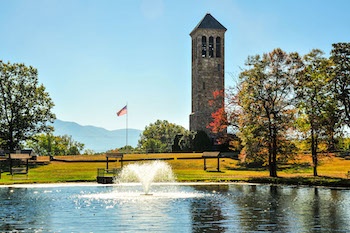
By Randy Arrington
LURAY, March 31 — During last week’s work session, Town Manager Steve Burke presented the Luray Council with a list of 17 projects and expenditures earmarked for $4.4 million in American Rescue Plan of 2021 funding. The federal funds being directed at localities is being allocated in two phases, with the first anticipated in the next 45 to 60 days.
The first phase funds will focus on COVID-related revenue losses that localities have seen as a result of the pandemic. The second phase will focus on infrastructure, to include paying down existing debt service on past capital projects as well as retrofitting existing structures. The funds can not be used for new capital projects.
President Joe Biden signed the American Rescue Plan into law on March 15 after Congress had passed the $1.9 trillion spending plan a few days earlier. The plan aims to provide funding sources for individuals, businesses, non-profit organizations and local governments to address the continued impacts of the COVID-19 pandemic.
The ARP follows two rounds of CARES Act funding that flowed into local coffers after being adopted in March 2020. CARES Act funding flowed from the federal level to the states. Virginia chose to (but was not required to) spread out a large amount of CARES money to county governments and school districts. The Page County Board of Supervisors chose to (but was not required to) share their CARES allotment with the county’s three towns. When ARP funds are distributed over the next two years, payments will go directly to the locality.
County Administrator Amity Moler told the board of supervisors on Tuesday night that the county anticipates receiving $4.6 million over the next two years from the American Rescue Plan. No announcements on anticipated ARP funds have been made by the local school division or the towns of Shenandoah and Stanley.
In addition to $1,400 checks, the American Rescue Plan helped individuals with unemployment compensation, health insurance premiums, food programs, child care programs, mental health programs and emergency help with rental assistance.
The ARP funding package provides the following for COVID-19 relief:
• $415 billion in increased funding for a national vaccination program, COVID-19 testing, contact tracing, scientific research and development, and manufacturing of pandemic-related medical supplies;
• $360 billion in funding to state, local, and territorial governments for economic relief and $20 billion in funding for public transit systems;
• $176 billion for education, with funds to assist K-12 schools in reopening by hiring more staff and putting in place new testing protocols, as well as funds for institutions of higher education;
• Funds toward cybersecurity efforts (including modernization of federal IT and networks).
The ARP funding package provides the following for businesses:
• Reimbursement for paid family sick leave up to $12,000 per employee;
• $7.25 billion in Paycheck Protection Program (PPP) funding;
• $15 billion in Economic Injury Disaster Loan (EIDL) funding;
• $25 billion Restaurant Revitalization Fund for 2021;
• Adds $1.5 billion to the $15 billion in shuttered venue operators grants;
• Adds $86 billion to support approximately 185 failing multi-employer pension plans;
• Adds $10.4 billion to support agriculture.
Burke told the Luray Council last week that the town’s $4.4 million would be dispersed over two years, with no more than half allocated in the upcoming fiscal year 2022. The funds must be used by Dec. 31, 2024. The town must adhere to the following guidelines in appropriating the ARP funds for the following uses:
• Response to the public health emergency with respect to the Coronavirus Disease 2019 (COVID-19) or its negative economic impacts, including assistance to households, small businesses, and nonprofits, or aid to impacted industries such as tourism, travel, and hospitality;
• Response to workers performing essential work during COVID-19 public health emergency by providing premium pay to eligible workers of the locality that are performing such essential work;
• Provision of government services to the extent of the reduction in revenue to the locality due to COVID-19 public health emergency relative to revenues collected in the most recent full fiscal year;
• Make necessary investments in water, sewer, or broadband infrastructure.
Burke presented a specific list of projects he earmarked for the ARP funding at last week’s work session. Council members voiced a desire to discuss the recommendations further, potentially soliciting input from the public before making a final decision. Several council members noted that the ARP funds do not come with the same time restraints that CARES Act funds came with last year.
“We’re not under the gun,” Councilman Joey Sours said. “We have time.”
Burke recommended hiring a part-time employee to coordinate the allocation of funds, as well as the extensive paperwork that comes with federal funds. Below is the full list of local spending recommendations that Burke made for the Town of Luray at the March 23 work session:
• Utility Payment Assistance — $50,000
• Business Grants — $250,000
• Non-Profit Grants — $100,000
• Chamber of Commerce Assistance — $50,000
• Luray Downtown Initiative Assistance — $50,000
• Hazard Pay — $155,000
• Town Budget Lost Revenues — $250,000
• Remote Read Water Meters — $625,000
• Water Fund Debt — $750,000
• Sewer Fund Debt — $750,000
• Water Treatment Plant Upgrades — $150,000
• Wastewater Treatment Plant Upgrade — $100,000
• Sewer Vacuum Truck — $250,000
• Sewer Main Lining — $500,000
• Water Main Upgrades — $325,000
• Website/Online Payment — $25,000
• Account Management — $30,000
Click here for a full description of the American Rescue Plan of 2021 funding.
•••
RELATED ARTICLES
Page County to receive second payment of $2M from CARES Act
Towns still recovering from delinquent water bills after resuming cutoffs, fees
Page County receives CONNECT 2020 grant to pay individual internet fees
Page’s effort to expand broadband gets $1.6 million boost from state
Page County moving forward with four initiatives to improve broadband service




Be the first to comment